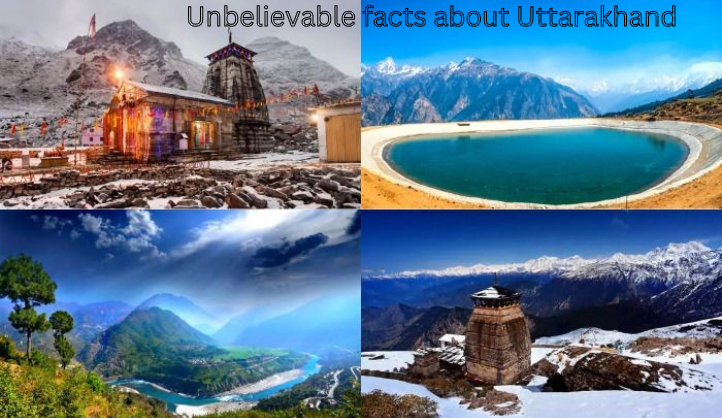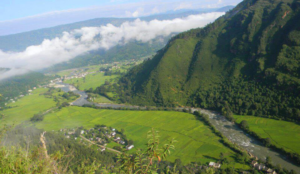Unbelievable facts about Uttarakhand
In Uttarakhand, also known as Devbhoomi or the Land of the Gods, there are incredible stories that seem like magic. One such story links the Kedarnath disaster, where many people were hurt, to the moving of a special statue in the Dhari Devi Temple. People say it made the gods unhappy. Another amazing thing is Roopkund Lake, high up in the mountains, where you find lots of old skeletons. Scientists say they might be from a group of people who came from Iran long ago. Then, there’s the Valley of Flowers, a place accidentally found by explorers in 1931. It’s like a magical garden with over 500 kinds of beautiful flowers.
Uttarakhand is also home to spooky places, like the Lambi Dehar Mines and Abbott Mount, where people talk about hearing scary sounds at night. Interestingly, Uttarakhand is the only state in India with Sanskrit as an official language, showing its love for ancient traditions.
The Champawat Tiger was a famous man-eater who caused a lot of trouble before being stopped by a brave hunter, Jim Corbett. There’s a 400-year-old canal made by a hero named Madho Singh Bhandari, and every 12 years, people walk 230 km in the Nanda Devi Raaj Jaat pilgrimage. Lastly, there’s a temple called Latu Devta Temple where only the priest can go inside, and he has to be blindfolded. And, believe it or not, the Nanda Devi peak might have a secret radioactive history from a mission in 1965. In Uttarakhand, every corner has a special tale to tell.
Dhari Devi Temple and Kedarnath Disaster:
The tragic Kedarnath disaster of 2013, claiming over 5,000 lives, is steeped in local beliefs connecting it to the shifting of the revered Dhari Devi statue. Dhari Devi, a highly venerated deity in Uttarakhand, had her statue moved from its original position on a small island in the Alaknanda River to accommodate a hydel project. Locals attribute the catastrophic flood that followed the statue’s relocation to the goddess’s wrath for being displaced from her sacred abode.
Skeletons of Roopkund Lake:
Roopkund Lake, perched at an altitude of 5,029 meters, is shrouded in mystery due to the discovery of numerous skeletons dating back to the 9th century. DNA studies hint that these remains belong to an Iranian group, possibly migrants in search of settlement. The lake’s enigmatic ambiance and the ancient origin of the skeletal remains have fueled various theories and speculations.
Valley of Flowers: A Floral Paradise:
The Valley of Flowers, nestled at an elevation of 3,658 meters, is a botanical marvel boasting over 500 different species of alpine flowers and shrubs. This natural wonder was stumbled upon accidentally in 1931 by British mountaineers returning from an expedition. Recognized for its exceptional cultural and physical significance, the valley was declared a UNESCO World Heritage Site in 1988.
Lambi Dehar Mines/Abbey Mystery:
Uttarakhand harbors eerie locations, and the Lambi Dehar Mines near Mussoorie stand out. Legends tell of as many as 50,000 mine workers meeting agonizing fates due to improper mining practices in 1990. Locals report chilling cries and wails at night, believed to be the spirits of the deceased workers haunting the abandoned mines. Abbott Mount in Champawat adds to the region’s haunting reputation, with tales of horrifying experiments conducted by a doctor in the 1920s.
Uttarakhand is the Only State with Sanskrit as Official Language:
Uttarakhand holds the unique distinction of being the only state in India with Sanskrit as one of its official languages, alongside Hindi. This linguistic choice reflects the state’s deep-rooted connection to ancient traditions, religious texts, and cultural heritage.
Champawat Tiger Who Claimed 450 Lives:
The infamous Champawat Tiger, a female man-eater, terrorized the forests of Champawat, claiming over 450 lives in Nepal and the Kumaon region. Its killing spree began in the 19th century in Nepal and escalated as the tigress crossed into the Champawat region. Renowned hunter Jim Corbett brought an end to the reign of terror by successfully shooting the man-eater in 1907.
Madho Singh Bhandari and 400-Year-Old Water Canal:
Madho Singh Bhandari, a valiant 17th-century commander, is remembered for his role in constructing a 400-year-old irrigation canal in Maletha village, located in the Tehri district of Uttarakhand. This canal, known as Maletha ki Kool, carved through massive rocks, still provides water to the once arid lands, showcasing the enduring impact of Bhandari’s efforts.
Nanda Devi Raaj Jaat: Longest Pilgrimage on Foot (230 km):
The Nanda Devi Raaj Jaat pilgrimage is a monumental spiritual journey covering 230 km on foot, making it the longest pilgrimage of its kind. Taking place every 12 years, devotees embark on a challenging trek from Nauti village near Karnaprayag to Roopkund, situated at an elevation of 5,000 meters, surrounded by the majestic Himalayan peaks.
Latu Devta Temple: Where Only Priest Enters – Blindfolded:
The Latu Devta Temple near Wan village stands out as a unique religious site where only the priest is permitted entry, and even then, the priest enters blindfolded. Devotees are allowed access to the temple only once a year during the Nanda Devi Raaj Jaat Yatra. The temple is dedicated to Latu Devta, the adopted brother of the goddess Nanda Devi.
Is Nanda Devi Peak Radioactive?:
The iconic Nanda Devi peak, soaring to an elevation of over 7,816 meters, holds a clandestine history. In 1965, a covert mission involving the United States’ CIA and India’s Intelligence Bureau aimed to install a nuclear-powered sensing device atop Nanda Devi to monitor China’s military activities. A series of ascents between 1965 and 1968 were undertaken to install and later retrieve the device. However, during the retrieval mission in 1966, the device was found missing. The plutonium capsules, designed to last over a hundred years, may still be buried somewhere in the snow-covered peaks.
Bonus Fact – Uttarakhand: Soul of Indian Army:
Despite its modest population of 10.08 million, Uttarakhand has a remarkable contribution to the Indian Army. It sends the highest number of officers per capita of the population to the Indian Army. This reflects the deep-rooted patriotism and commitment of the people of Uttarakhand towards protecting the nation’s integrity and sovereignty. While Uttar Pradesh may have the highest total number of officers in the Indian Army, Uttarakhand leads when considering the ratio of officers to the state’s population.
Hemkund Sahib – Sikh Pilgrimage in the Himalayas:
Hemkund Sahib, situated at an altitude of 4,329 meters, is a significant Sikh pilgrimage site surrounded by snow-capped peaks. The Hemkund Lake, near the gurudwara, is believed to be a meditative spot mentioned in the Guru Granth Sahib. The journey to Hemkund Sahib is not only a pilgrimage but also a trek through breathtaking landscapes.
Conclusion:
Uttarakhand, with its mountains and stories, is a place full of wonders. Whether it’s the magic of flowers in the Valley of Flowers or the mysterious skeletons at Roopkund Lake, every place has a unique tale. The spooky Lambi Dehar Mines and the haunted Abbott Mount add to the mystery. With Sanskrit as its official language, Uttarakhand holds on to ancient traditions. Stories of brave heroes like Madho Singh Bhandari and the Nanda Devi Raaj Jaat pilgrimage show the deep connection to culture. Even the Champawat Tiger, once a danger, became a part of the state’s history. Uttarakhand, with its temples and peaks, is truly a land of extraordinary stories.
Frequently Asked Questions (FAQ):
Why do people link the Kedarnath disaster to the Dhari Devi Temple?
Some believe that moving the special statue in the Dhari Devi Temple upset the gods, and this might be connected to the disaster in Kedarnath.
What is so special about Roopkund Lake?
Roopkund Lake is special because it’s high up in the mountains and has many old skeletons. Scientists think these skeletons are from a group of people who came from Iran a long time ago.
Why is Uttarakhand known as the Valley of Flowers?
The Valley of Flowers got its name because it’s like a magical garden with over 500 different types of beautiful flowers.
Are there spooky places in Uttarakhand?
Yes, places like the Lambi Dehar Mines and Abbott Mount are said to be spooky, with stories of scary sounds at night.
Why is Sanskrit important in Uttarakhand?
Sanskrit is important in Uttarakhand because it is one of the official languages, showing a connection to ancient traditions and culture.





